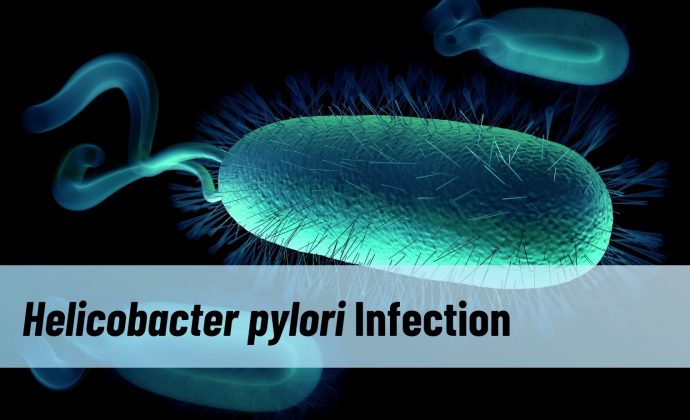
HELICOBACTER PYLORI INFECTION
Helicobacter pylori is a gram-negative bacterium that can infect the stomach. The infection can damage gastric tissue and parts of the small intestine. This can cause redness and pain (inflammation). In some cases, it can also cause painful sores called peptic ulcers in the upper digestive tract.
Helicobacter pylori attack the lining that protects the stomach by making the enzyme urease which makes stomach acid less acidic (neutralizes it), which weakens the stomach lining. Thus, gastric cells are at greater risk of being injured by acid and pepsin, a strong digestive juice. Then it can cause ulcers in the stomach or duodenum.
H. pylori bacteria can also attach to gastric cells. Then, the stomach cannot protect itself. Eventually, the area where the H. pylori are attached becomes red and swollen (inflamed). H. pylori can also make the stomach produce more acid.
Transmission of Helicobacter pylori
The mode of transmission of H. pylori is not known with certainty. H. pylori can be transmitted directly from person to person or indirectly from the environment to person. Person-to-person transmission is considered the main mode of transmission, especially in developed countries. Transmission through food and water is more likely in developing countries and H. pylori spread more rapidly in areas with poor hygienic conditions.
Person-to-person transmission is thought to occur via the oral–oral, fecal-oral, gastric–oral, or sexual routes. In many cases of transmission of H. pylori, infection occurs fecal-oral or oral-oral through consumption of water or food contaminated with H. pylori bacteria.
Risk Factors for Helicobacter pylori Infection
A person is at greater risk of H. pylori infection if:
– Live in an area with poor sanitation
– Consuming drinking water that is not cooked until cooked
– Eating raw vegetables
Most people first get the bacteria when they are children, but adults can get it too.
What are the tests to confirm if a person is infected with Helicobacter pylori?
Serology Test. This examination is carried out to determine whether there are infection-fighting cells (antibodies) against H. pylori that are formed by the body in the blood as a marker of the presence of bacteria in the body.
Stool culture. This test is to find out if there are abnormal bacteria in the digestive tract that might be causing diarrhea or other problems. A fecal sample will be collected and sent to the lab for examination. Then, after 2 or 3 days the test results will show whether there are abnormal bacteria or not.
Urea breath test. This examination uses the action of the enzyme urease from the bacterium H. pylori The patient will be asked to take a substance that contains urea, if there is an increase in the production of carbon dioxide through the breath, meaning that there is an H. pylori infection in the gastrointestinal tract. This examination is the main examination, where patients who show positive results will be advised to undergo eradication therapy.
Esophagogastroduodenoscopy (EGD). This examination will look at the esophagus, stomach, and duodenum using an endoscope. H. pylori can be detected by several methods – including looking at a small tissue sample (biopsy) under a microscope, using a chemical reaction (rapid urease test), or growing it in a laboratory. A missing sampling of H. pylori or taking antibiotics or currently taking medications for ulcers can lead to false-negative results.
What are the complications of Helicobacter pylori?
If you are infected with H. pylori, you can develop stomach ulcers. In addition, you can also suffer from very severe ulcers. So it can cause problems like:
– Bleeding when blood vessels wear out
– There is a hole or perforation in the stomach wall
– Blockage occurs when the ulcer is in a place that prevents food from leaving the stomach
In addition, H. pylori can also cause stomach cancer.
Helicobacter pylori infection treatment
Treatment is done by giving drugs to reduce stomach acid production and a combination of two to three antibiotics. Four weeks after treatment, re-evaluation by examination of urea breath test. A negative result indicates the success of the treatment.
Source:
ztekin, M., Yılmaz, B., Ağagündüz, D., & Capasso, R. (2021). Overview of Helicobacter pylori Infection: Clinical Features, Treatment, and Nutritional Aspects. Diseases (Basel, Switzerland), 9(4), 66. https://doi.org/10.3390/diseases9040066
Digestive Health Foundation. (2010). Information of Helicobacter pylori (H.pylori). Information leaflet for patients and interested members of the general public Third Edition.
https://www.hopkinsmedicine.org/health/conditions-and-diseases/helicobacter-pylori
Image source: Getty Images





 Users Today : 382
Users Today : 382 Total views : 2129215
Total views : 2129215 Who's Online : 6
Who's Online : 6